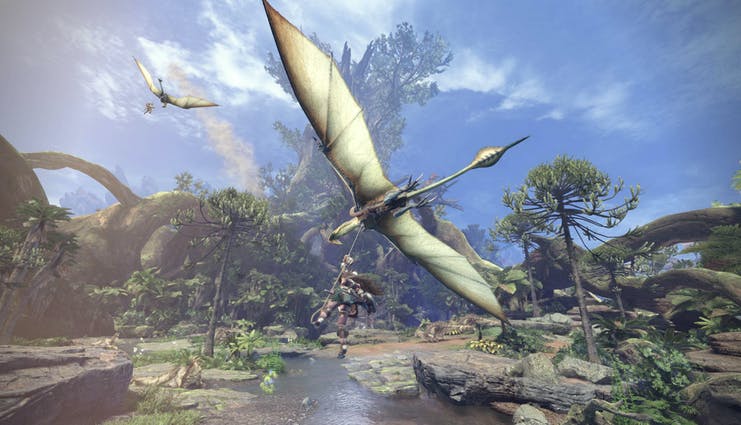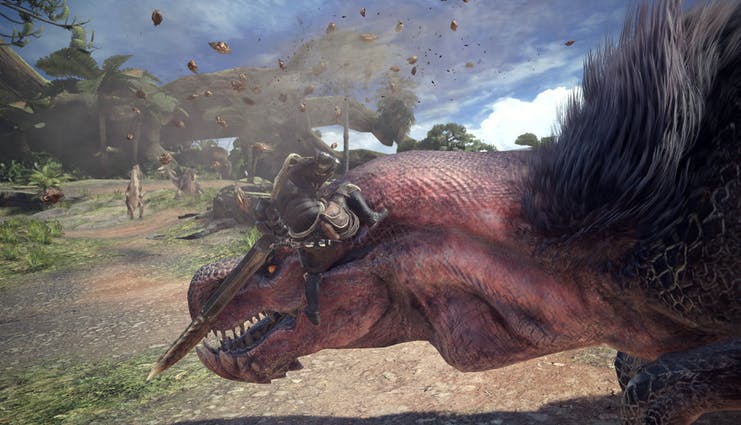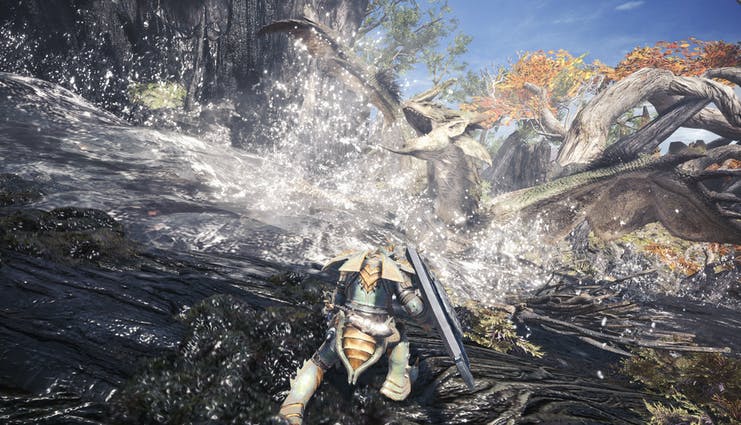Big game hunting.
Dramatic upheavals in the behavior of the Elder Dragons–fierce creatures perhaps best described as forces of nature–have resulted in you being sent to investigate what’s happening in the New World. For reasons that are initially unknown, all of the Elder Dragons are migrating to one particular spot, and you, along with the rest of your fleet, are being sent to find out why as the central conceit of Monster Hunter: World. Along the way, you’ll familiarize yourself with the New World and follow the clues you find in the various environments to find the reason behind this so-called Elder Crossing, all while fighting large monsters, gathering resources, crafting new weapons and armor, and supporting your home base of Astera. All in the name of science.
It’s a lofty goal but one betrayed by colonialist undertones and a controversial method of research.
“There’s very little scientific justification for going on a hunt because you want to finish a full armor set”
As the title implies, this is a game about fighting large and dangerous creatures, often unlike anything that exists in our world. The game rationalizes sending you to kill these monsters in a number of ways. First, they’re a direct threat to Astera and the Research Commission at large. Second, they’re a threat to the aforementioned Elder Dragons, and the research surrounding the Elder Crossing phenomenon. Finally, there exist never-before-seen-to-the-Commission species that they want to research; they get the best bang for the buck by slaying or capturing them, not by merely observing them.
READ MORE: Hylke Langhout gives a brief rundown of the game’s systems in his love letter to the game (external link)
The environmental implications of this are kind of messed up. Ultimately, the Research Commission is still intruding on the habitats of the native fauna and killing them en masse under the guise of scientific research. This draws obvious parallels to Japan’s current whaling industry using the scientific research clause in the International Convention for the Regulation of Whaling to continue its operations of killing whales under the pretense of science. Indeed, of some 3600 whales killed under the program by the Japanese, it appears only nine were used for scientific purposes.
The parallel to Monster Hunter: World is clear here: the player is part of a research group but the game instead frames hunting monsters as an inherently fun thing, something that delivers rewards you can use for your own benefit.
Because this is a game made primarily for entertainment, you don’t have to worry too much about issues like biodiversity and preservation of wildlife. There will always be enough monsters to hunt for when you need a new piece of armor. But that is something we do need to worry about in real life, and the way Monster Hunter: World goes about its business like everything’s fine is worrisome.

Why isn’t observing the monsters in the wild not enough for the Research Commission? Must they go out day after day, putting their lives on the line to fight fire-breathing Tyrannosaurids and dragons that can freeze creatures all the way through? Why must those creatures forfeit their lives?
We’ve seen cases made in the real world that killing animals specifically for research has little effect on the population numbers of those animals but it feels a bit different in Monster Hunter: World. Hunting monsters is the core gameplay of the series, and anything beyond the first story mission is done not because you need to, but because you want to. There’s very little scientific justification for going on a hunt because you want to finish a full armor set. It would be a very different game if they didn’t. Doing this is the entire point of Monster Hunter, and I would be lying if I said I didn’t enjoy every second of the 180+ hours I’ve spent on the hunt.
NON-LETHAL ALTERNATIVES
Instead of killing animals, researchers have a number of tools available to them, including the use of photography, audio recordings, and non-lethal testing using swabs, aspirations, and the like on captured specimens. Extended observation periods in nature complete with detailed notes and sketches can be valuable resources. In certain circumstances, museums and other institutions can house live exhibits, though these should be supervised by an ethics committee to ensure appropriate treatment.
This article from the University of Alaska Museum Department of Ornithology argues that the collection of samples and specimens is important for research into how biodiversity changes, and explains the responsible ways that samples are collected, both live specimens and salvaged dead ones. If we contrast this with the way the Research Commission in Monster Hunter: World does things, we find some pretty stark differences. They rarely ever salvage dead specimens: Their priorities are in the slaying or capturing of live monsters instead.
Gathering tracks and fighting monsters gives you levels in the Ecological Research Center. The more levels you have, the more information you have about each monster, but the information is rarely along the lines of its distribution, habitat or behaviours. Instead, you learn weak spots and where to carve to get the parts you need for new sets. Undeniably important for a hunter, to be sure, but not really helpful for understanding how these monsters live, or how they behave.

Colonialist themes abound. Between building a base of operations in a place thought to be uninhabited and literally calling it “The New World”, one can easily draw a real-world parallel to the process by which European countries colonized and conquered the Americas and Australia. Like those real-world examples, the game’s New World was not actually uninhabited, either. While this new world may not have had any human inhabitants, it absolutely had tribes of Lynians, sentient bipedal cats, in almost every region of the continent, and even a small population of First Wyverians, ancient humanoids with wyvern ancestry.
Monster Hunter: World skirts around the idea of colonialism by having the Research Commission and the indigenous population frequently helping each other out and living in harmony. But it still falls into the tired trope of the native population of a continent being tribal and “savage” compared to the technologically advanced colonists, a theme displayed in books such as Heart of Darkness by Joseph Conrad or Under The Pyramids by H.P. Lovecraft, to say nothing of how the settlers of Turtle Island relied on the First Nations for even basic survival.
“The environmental implications of this are kind of messed up”
Frantz Fanon’s The Wretched of the Earth is a foundational text of postcolonial literary criticism that argues that the colonial perspective of pre-colonial countries is a sort of historyless limbo. Basically, that colonists believe the country’s history doesn’t really matter until it gets colonized. Monster Hunter: World features this perspective as well with its native Lynian population. For example: a side quest in the Iceborne expansion finds you following the ancient journal entries of the first Gajalaka tribe spiritual leader to come to the Elder’s Recess region and how he communicates with the spirits of the land to safely settle there. It’s a fun little bit of environmental storytelling but the game approaches it with a sort of charming bemusement. Lynians fill many roles in this game, from trusty partners to native population to comic relief, but the game doesn’t really explore their society beyond these snippets that you must go out of your way to do.
Furthermore, the base game’s ending is bothersome from a post-colonial perspective. At the end of the game, you find out the reason behind the Elder Dragon Crossing and solve the problem that was causing it. The stated goal of coming to the New World has been achieved and the research team should, logically, be packing up to head home.
But they don’t.
The New World branch of the Research Commission makes a unanimous decision to stay in the New World because they like it so much. And in the Iceborne expansion, they make yet another base in the frozen north of The Hoarfrost Reach, not only extending their stay past the parameters of their mission essentially for fun, but expanding their presence into other areas as well.

Gaming has grappled with the place of artful criticism for years but it’s at a fever pitch now with games like The Last of Us Part II and Ghost of Tsushima drawing meaningful criticism despite ostensibly being “fun” experiences. We need to look at games beyond being a series of entertaining mechanics and meaningfully examine the implications of the stories they’re telling. We can’t really afford to engage with our media uncritically anymore, because that way some pretty heinous stuff can slip through the cracks. We should, both as critics and consumers, be taking the motivations for why things are the way they are into account. Sometimes it can be as harmless as “because it’s more fun that way”, but sometimes there can be deeper motivations behind a game’s design. We’ve seen games become less rewarding to sell us loot boxes, all in the interest of making more money by exploiting vulnerable people.
It’s possible to love something while also being aware of its flaws: Monster Hunter: World ranks among my favourite games of all time. It’s an absolute blast as a social experience but just as fun to play solo, as its core loop of hunting and crafting feels incredibly rewarding. It’s challenging but not unfair, and it makes you feel really accomplished for overcoming its many difficult tasks. That doesn’t insulate it from all criticism.
Hylke Langhout has been writing about games since 2012 and believes in their artistic value and the social power of play. He plays both board games and videogames regularly and wants you to do so as well. You can find him on Twitter at @Gear12_Turbo and his WordPress blog.
